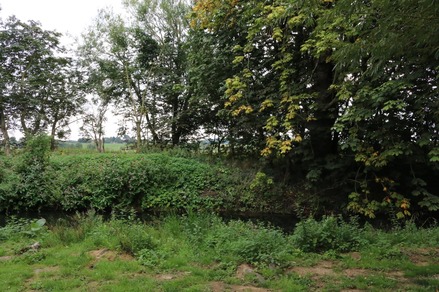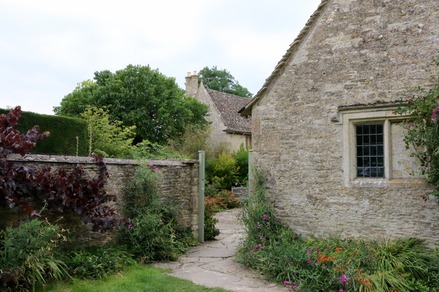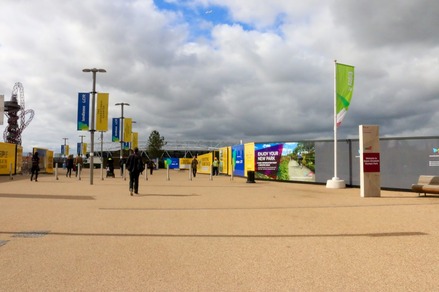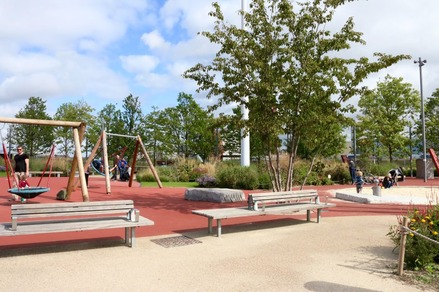
An Essay on a Study Tour to Oxford and London 洪 美怜
A Road That Leads to the Far East
This is a short essay on a one-week study trip to U.K. as part of the IHS Educational Project 1. As a group of six students and five professors, we stayed in Oxford for two days, visited Blenheim Palace and Kelmscott Manor for a day, and then explored London for four days. Since Educational Project 1 aims to study the "Shape of Life," I have speculated on a few things and places, which urged me to rethink our current way of life in particular. As a researcher of urbanization, I consider this matter in terms of peoples' spatial sensibilities, referring to a map-like drawing, a theater play and gentrified scenery of London that we saw during the tour. Necessarily, I omit quite a number of other good and interesting experiences. There are no doubt many other things to learn from this study tour, and this essay is merely a sample analysis of the many lessons that unfolded to us as we encountered new things, places and people.
1. At Kelmscott Manor
A river flows in a circular orbit. That is the center of the world. Two roads stretch within the circle of water, drawing the shape of a Greek cross on the ground. At the upper end of the cross stands a house, a very humble one with red roof and white walls. The rest of the round island is a great habitat for plants and animals, mostly domestic or familiar ones; a gaggle of geese are taking a walk; across the road lies a dog; fruits are ripening on the trees under which an ox is resting and rabbits are eating; a cat, and a hen and her chicks are crossing the road in opposite directions; another dog and cat are locked in a verbal standoff, while birds are singing to one another.
In the body of water, the vegetation becomes less familiar; an alligator raises its face out of the river, and one can see frogs playing on the edge of the water, but there are a couple of swimming creatures which look like fish yet defy identification. Outside the water spreads an exotic terra. Herbivorous animals such as deer are juxtaposed with their predators like a tiger and a leopard, and even some from other climatic zones, owls and parrots, for example, are there in one place together.
This is the design of the Jane Morris' bedcover, now exhibited in her own bedroom at Kelmscott Manor. The scene described above was embroidered by her based on a drawing by May Morris, her youngest daughter, who later became an embroidery designer. At first sight, it looks like just any other handmade work by the family embroiderer, not professional, perhaps even a little childish. Yet in a sense, however, this bedcover design can be regarded as the greatest expression of May's inheritance from her father, William Morris, who respected the craftsmanship of the medieval age, and perhaps, this shows in the way young May, consciously or unconsciously, translated the medieval ideas into contemporary works.
In the medieval period, when theology was the most highly regarded subject in all academia, the world was believed to be surrounded by a circular ocean, and to be divided by a T-shaped waterbody. Therefore, world maps of those days are now called T-O maps. The three pieces of land were Asia, Africa, and Europe, clockwise from the top. And as usual with pre-modern maps, the farther it goes from the center, the more imaginary things become. (For instance, on one of the most famous T-O maps in Hereford Cathedral, there are Blemmyes on the edge of the world.)
The bedcover design reminded me of these features of T-O maps. Though there are some differences, such as roads and rivers to divide the circular land, for example, what made the association strong for me was the direction: T-O maps put east on the top in the belief that Eden should be located at the eastern end of the world, namely the heart of Asia. And on the bedcover, the sun is about to rise from mountains on the top, meaning that the white-walled house is in the Far East. (The sun could be seen setting, yet I suppose the embroidery of a bedcover beneath which one sleeps till morning should be the rising sun.) If my analysis is correct, that little house is meant to be an earthly paradise.
Nonetheless, there are differences between T-O maps and the bedcover design that make me wonder further. In May's design, there is a straight way heading for the easternmost edge whereas it is the forbidden and therefore very inaccessible garden for humans on the maps. I am not sure whether she was aware of medieval cartography when she drew the design, but I assume there is an influence from it. And if so, conscious or not, did she believe that there was a clear way to reach a paradisiacal place, or homely place? Or is it just an expression of her ideals like her father's News from Nowhere? I wondered when I left Kelmscott for London.


2. In the Olympic Park
I felt as if I were in the middle of nowhere. No, I was standing in the middle of the Queen Elizabeth Olympic Park in the East End of London. There were different types of beautiful gardens from different parts of the world (in order to showcase the global mindset of Olympic Games, the tour guide told us), smartly planned and built arenas, among which was one designed by Zaha Hadid, and there were still several construction sites around the park for boosting the local economy. Indeed, we were in and walking through a space that has so many things that are supposed to be seen and praised. But I could not stop feeling great emptiness here.
First and foremost, things in and around the park seemed to be built beyond the ordinary human scale, physically and economically. This used to be a conglomeration of Olympic venues, so things should be gigantic in size, obviously. Yet very broad walkways that remain today, huge gleaming shopping malls nearby the station, condominium complexes mostly developed after the Games, however, contrast starkly with the size of people hanging out around here, creating an almost surreal landscape. It reminded me of Jane Jacobs's criticism of urban development in post-war American society: "Cultural events that are unable to support a good bookstore...Commercial centers that are lackluster imitations of standardized sub-urban chain-store shopping...promenades that go from no place to nowhere and have no promenaders" (Jacobs 1993:6).
The guides told us that buildings under construction around the park were mainly business offices. But quite a few will be, and indeed some of them had already been housing rooms for rent. Pointing out such a building, shaped like a broken chocolate bar, one guide said that the room rents in that building were around two hundred pounds for a week although it is just student accommodation. That is absolutely beyond ordinary people's reach. It was in the daytime so we could not exactly count vacant rooms, yet nevertheless I was quite sure that many of the rooms were not occupied.
But probably, it was the resemblance between the landscapes and the historical backgrounds of the East End and that of the bay area of Tokyo, which I have been researching for a few years, that made me strongly feel the sense of nowhere. For a long time, both had been industrial areas with factories and lower income households. Yet one cannot see that nowadays since developers have scrambled to build luxury apartments and condominiums, replacing local people's houses. In the East End of London, this process of replacement has been greatly boosted by the Olympics. In Tokyo it has been occurring for about two decades, though the pace of development has been increased due to speculation induced by the 2020 Games.
As for the case of London, it has sometimes been criticized because the development process evicted and displaced some people from their long-term homes, though, according to the tour guides, there were very few people who found themselves in this trouble. (These displaced people were finally offered apartments in the reconstructed Olympians' accommodation at a very decent price. However, the end of the story is that much more gorgeously reconstructed rooms, occupying half of the reconstruction, were bought by money from the UAE.)
On the contrary, the development of the Tokyo bay area has hardly been criticized; it has not brought about displacement of poor people which often happens as a result of the so-called gentrification process. Nonetheless, a closer look at local history tells that this phenomenon actually happened during the build up to the Olympic Games during the late 1930s. Indeed, after the Pacific War, local historians have revealed that foreign laborers, mostly from the Korean peninsula, a former colony of Japan, were evicted from their shacks and ordered to live on a rectangular-shaped piece of reclaimed land in order to clean up the expected venues for the 1940 Olympic Games. (Koh 2014). Tokyo abandoned its plan to host an Olympics two years before the event because of the intensification of the Sino-Japanese war during late 1930s.
What happened in London is divided into two parts, displacement and development, the same processes were executed separately for different Olympic occasions in Tokyo.


3. Absent and a few thoughts at the end of the tour
I am concerned about what will happen to Tokyo around 2020. The night of the day that we went to the Olympic Park, a theater play, Absent, once again made me think about this matter. (In this play, the audience is supposed to walk through the settings of abolished hotel rooms instead of being seated and watching the stage from the distance.) At first glance, the plot appears just mysterious; stories of a young lady and of an elderly lady (perhaps very aged but the same person as the former) run in parallel in the same setting of the same hotel. It looks as if we had to detect what happened to her as we walked through the settings and the plot developed. Yet in the end, nothing becomes clear and instead just some pieces of information are given to the audience; she is a duchess, used-to-be rich, rumored to have gone bankrupt, now moving from hotel to hotel as developers renovate old accommodation and require her to move out. Although her riches are in the past and the luxurious settings of old hotels make the play mysterious or even scary (indeed some settings reminded me of Shining, a horror film by Stanly Kubrick), it made me wonder what such a life would be like, a life where one has to move from one place to another at the mercy of the orders of people with power.
As the play goes on, most information is shown in fragments of newspapers or tabloids, left in the abolished hotel rooms. And one headline reads, "Investment Now like Sports Events". True, I thought. Investment and development can be like a heated spectacle especially when sports events are to be hosted, or vice versa.
When our tour came to an end, once again I remembered the bedcover design by May Morris. Based on the comparison with medieval T-O maps, the little house on the top of the round terra could mean an earthly paradise which is supposedly somewhere in the easternmost part of the world. And there is a strait, direct way to reach that sweet home. Tokyo, a metropolis in the Far East, is the host city of the Olympics in five years, where investment and development have already been stimulated in its bay area. I wonder if there could be a way to get to the Far East of May's ideal, a homely place filled with joyfully active living. Or I have to find out a way to construct such a road as a researcher of urbanization.
References
- Jacobs, J. (1993) The Death and Life of Great American Cities. Modern Library.
- Koh, M. (2014) Women and Homeplace Making in a Korean Minority Community in Japan: A Case Study of Edagawa, Tokyo. Building Global Networks though Local Sensitivities: Japanese Researchers' Contribution to Gender and Geography. pp. 57-70.
- Hereford Mappa Mundi, a T-O map owned by the Hereford Cathedral, can be seen from the following link; http://www.themappamundi.co.uk/mappa-mundi/


